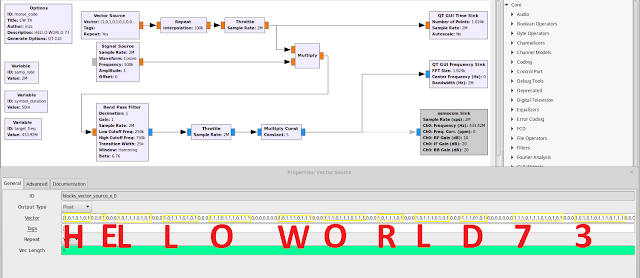The below flowgraph bitbangs some predefined Morse code on an ISM band using Gnuradio companion.
After a speed reading about ITU Morse code at https://en.wikipedia.org/wiki/Morse_code and http://morsecode.scphillips.com/morse2.html I randomly decided that one unit was going to be exactly 50 milliseconds. I also randomly chose the following as the message I would transmit - "HELLO WORLD 73 ".
With the rules for International Morse code and the dah dit encoding for letters I made the below bit-banging table.
- short mark, dot or "dit" (·) : "dot duration" is one time unit long
- longer mark, dash or "dah" (–) : three time units long
- inter-element gap between the dots and dashes within a character : one dot duration or one unit long
- short gap (between letters) : three time units long
- medium gap (between words) : seven time units long
| H | .... | dit dit dit dit | 1010101 |
| Letter Gap | 000 | ||
| E | . | dit | 1 |
| Letter Gap | 000 | ||
| L | .-.. | dit dah dit dit | 101110101 |
| Letter Gap | 000 | ||
| L | .-.. | dit dah dit dit | 101110101 |
| Letter Gap | 000 | ||
| O | --- | dah dah dah | 11101110111 |
| Word Gap | 0000000 | ||
| W | .-- | dit dah dah | 101110111 |
| Letter Gap | 000 | ||
| O | --- | dah dah dah | 11101110111 |
| Word Gap | 0000000 | ||
| R | .-. | dit dah dit | 1011101 |
| Word Gap | 0000000 | ||
| L | .-.. | dit dah dit dit | 101110101 |
| Letter Gap | 000 | ||
| D | -.. | dah dit dit | 1110101 |
| Word Gap | 0000000 | ||
| 7 | --... | dah dah dit dit dit | 1110111010101 |
| Letter Gap | 000 | ||
| 3 | ...-- | dit dit dit dah dah | 1010101110111 |
| Word Gap | 0000000 |
So I created a vector source with the above information and use On Off Keying, of which Morse code is a subset.
(Thanks : https://zeta-two.com/radio/2015/06/23/ook-ask-sdr.html )
Vector:(1,0,1,0,1,0,1,0,0,0,1,0,0,0,1,0,1,1,1,0,1,0,1,0,0,0,1,0,1,1,1,0,1,0,1,0,0,0,1,1,1,0,1,1,1,0,1,1,1,0,0,0,0,0,0,0,1,0,1,1,1,0,1,1,1,0,0,0,1,1,1,0,1,1,1,0,1,1,1,0,0,0,1,0,1,1,1,0,1,0,0,0,1,0,1,1,1,0,1,0,1,0,0,0,1,1,1,01,0,1,0,0,0,0,0,0,0,1,1,1,0,1,1,1,0,1,0,1,0,1,0,0,0,1,0,1,0,1,0,1,1,1,0,1,1,1,0,0,0,0,0,0,0)
154 units x 50 ms = 7700 milliseconds, or 7.7 seconds to transmit "HELLO WORLD 73 "
50ms (0.05 seconds) at 2MSPS would be 100000 samples per dit (and 300000 samples per dah).
So I used a "repeat interpolation" block that repeats each unit for 100,000 samples. And then I multiply my cosine carrier at 500kHz with this to implement my On Off Keying. If it is 100,000 "zeros" then cosine is turned off and if it 100,000 "ones" then the cosine is turned on.
(click on the above image to see it full screen) I don't have a LimeSDR yet (will be almost half a year until the crowd funded rewards arrive) so I'm just using a disabled generic sink block.
100,000 zeroes

100,000 ones. I'm using a float to complex bandpass filter (with complex taps) to attenuate the negative frequency component by around 80dB which should be below the noise floor of the transmitter.
Unfortunately a nasty spike will be transmitted because of the DC imbalance between I and Q at 433.42MHz. Normally you would have a bandpass filter on the TX output and have this spike buried well inside the filters rejection band. So that you are not broadcasting the spike, and polluting the RF spectrum. Depending on the frequency you could be breaking the law, and risking hefty fines. But since the spike will be inside the ISM band and I only plan to run this flow graph for at most 60 seconds, I am ignoring this problem for now.


No comments:
Post a Comment